Damping off is a fungal disease found in nurseries where the seedlings are found to be overcrowded. It is commonly seen in many vegetables immediately after monsoon showers.
Damping off (Pythium aphanidermatum)
|
|
Symptoms
There are two different types:
Pre-emergence damping off:
The young seedlings are killed even before they emerge from the soil. The fungus attacks the germinating seeds and they rot even before the hypocotyls emerge. Since this happens in the subsoil it cannot easily be spotted by the farmers who may have been misled on the quality of the seeds.
Post-emergence damping off
This phase is characterized by toppling over of infected seedlings at any time between the period that they emerge from the soil and the stage the stem hardens to resist pathogen attack. Infection affects the stem at the ground level or spreads through the roots.
The affected seedlings are pale green with a brown water soaked lesion at the base of the stem. Later, the lesion girdles the stem and spreads both upwards and downwards. The affected tissues are soft and water-soaked and they usually rot, leading to the collapse of the seedlings. The disease starts in patches and spreads to the entire lot in the nursery in the course of 2–4 days.
Causal agent
Pythium is the most common species of fungus responsible for damping off disease in seedling nurseries. The fungus has a characteristic mycellium and reproduces both sexually and asexually. Sporangia aid in asexual reproduction. Sexual reproduction is characterized by the formation of oogonium, antheridiums and zoospores. Disease cycle The pathogens are soil borne. They are week saprophytes and poor parasites. They remain in the soil as zoospores during adverse conditions and germinate when there is sufficient moisture. The zoospores germinate to produce mycellium which multiplies rapidly and infects the host tissues. The occurrence is more in heavy and compact soils that are not well drained and which do not have proper aeration. Temperatures between 27–31 oC are conducive for spread. High moisture content, close planting and poor aeration predisposes the seedlings to damping off.
Management
- Use certified seeds.
- Partial sterilisation of the soil by surface burning of a thick
stack of farm trash; solarisation by covering the nursery bed
with alkathene.
- Formation of raised beds with better drainage facilities. • Application of 400 gm of neem cake per sq. m. of nursery
bed 15 days before sowing, and watering at 3–5 days'
interval.
- Use of light soil for nursery beds, thin planting, light and
frequent irrigation and application of well decomposed
manure.
- Seed treatment using leaf extract of Bougainvillea glabra (@
20ml per litre of water) for six hours.
|
Early blight (Alternaria solani)
|
|
This is one of the most common diseases of the potato and is also found to attack the tomato. Since the disease appears early in the season, it is known as early blight.
Symptoms
The pathogen produces leaf spots of varying size. The spots are irregular in shape, dark brown in colour with concentric lines in the centre. In severe cases of infection, several spots coalesce to form large patches resulting in leaf blight. In advanced stages, the disease causes defoliation of plants, exposing the fruits to sun, causing sunscald. Under suitable environmental conditions the fungus can cause damping off and collar rot. Occurs at the seedling stage and with older plants.
Causal agent
The fungus produces mycellium which has both inter and intra cellular cells in the host tissues. They survive as conidia and remain viable in the soil at 0–12 cm depth for twelve months.
Disease cycle
The pathogen is air borne. The lower leaves are more susceptible than the upper ones. Infection takes place slowly and plants grown under high moisture conditions are highly susceptible.
Economic injury level
One diseased leaf for every four healthy leaves or 25% damage
Management
- Crop rotation with a non-solanaceous crop.
- Do not grow tomato in soils where potato was intensively cultivated.
- Remove infected plant parts such as branches, leaves, buds, and burn them.
- Destruction of collateral host is desirable.
- Spray 5% eucalyptus or lantana leaf extract in the evening.
- Diluted cow dung can be applied to the root zone of the affected plants.
- Treatment with Trichoderma viride or Pseudomonas fluorescens @ 5 gm/100 gm of seeds.
|
 |
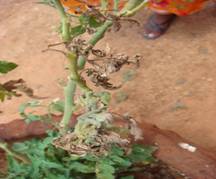 |
| |
| |
| |
Late blight (Phytophthora infestans)
|
|
Late blight is a very serious disease of the potato which also attacks the tomato. The disease was introduced from Europe to India between 1870 and 1880. In hilly areas the disease first attacks the tomato and then spreads to the potato. The fungus attacks any aerial part of the plant.
Symptoms
The disease appears on the foliage as water soaked light brown lesions. Under favourable climatic conditions (humid and cloudy weather), the lesion spreads to the entire leaf and petiole causing brown dead spots. The entire leaf may be killed in 1–4 days, if the weather is moist. Under dry weather conditions, the spots remain restricted in size and the dead areas appear hard and break away easily from the rest of the lamina. Whitish growth of fungus can be seen on the lower surface on close examination of infected leaves. Severely diseased plants wilt in a few days causing severe loss in crop yield. Dark olive greasy spots are found on the fruits and the tissues remain firm. Blight is followed by soft rot due to invasion by secondary pathogens.
Causal agent
The fungus produces zoospores under advanced conditions. They spread both inter and intra cellular-wise in the host, producing free branching hyphae.
Disease cycle
Sufficient soil moisture and suitable temperature favourthe the germination of sporangia. They spread through diseased seedlings and fruits.
Management
Five kilos of wood ash should be mixed with 50 litres of water and kept aside for two hours. The extract should then be strained and used as a spray to control late blight. Dried powdered ash can also be applied to the crops. |
Fusariam wilt (Fusarium oxysporum f. lycopersici)
|
|
This is a very serious vascular disease of the tomato common in temperate regions. It also occurs in warmer areas.
Symptoms
Fusarium wilt causes clearing of vein lets, chlorosis of leaves and drooping of petioles. The young leaves die in succession and later the entire plant will wilt and perish in a few days. The symptoms may appear only on a few branches. Dark brown or black discolouration of vascular tissues may be seen in the roots or basal portion of the stem when the disease is in an advanced stage of infection. The plants remain stunted due to the pathogen attacking the roots. Under humid conditions, pinkish fungal growth can be seen on the dead plants.
Causal agent
The fungus produces both macro conidia and micro conidia. Fungal hyphae spread both inter and intra cellular in the host tissues. Disease cycle The disease is soil borne and the pathogen is present as a saprophytic ally in the soil for several years. A temperature of around 28 oC is optimum for development of the disease. The disease is more severe at a pH less than 6.4 and greater than 7. Short day length, low light intensity, low nitrogen and phosphorus and high potassium predispose the plants to the disease. The fungus multiplies rapidly within the host tissue, clogs the vascular tissues and interferes with the transportation of water and nutrients upwards thereby resulting in the wilting of the plants. A few research reports also suggest that wilting is caused by the toxins produced by the fungus.
Management
- Crop rotation with non-solanaceous crops reduces inoculums in the soil.
- Seedling root dip in a solution containing ten grams each of turmeric and asafetida dissolved in a litre of water is preferred before transplanting.
- Keep the fruits away from the soil by proper training and pruning.
- Pull out the affected plants and destroy them.
- Use varieties like Mar globe, Kanora, Sioux and Roma which are resistant.
- Spray fifteen days' old panchagavya, diluted with ten parts of water.
|
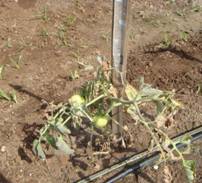 |
 |
| |
| |
| Fruit rot |
|
Phytophthora infestans, P. palmivora and P. parasita are associated with fruit or stem rot of tomato plants in India. This disease occurs under humid weather conditions. The other species of fungi causing fruit rot both in the field and in storage are Fusarium sp., Alternaria solani, Rhizopus sp. and Erwinia sp. The extent of damage depends on climatic conditions, cultivation methods and handling in transit and storage. Good phytosanitary measures can reduce attacks by these fungal pathogens. |
| Root and collar rot |
|
Caused by Fusarium solani, Sclerotium rolfsii, Rhizoctonia solani and Macrophomina phaseolina. These are soil borne pathogens also found in crop debris. They can be controlled by uprooting the diseased plants along with the infested soil and burning them. |
| Anthracnose / Ripe fruit rot (Colletotrichum phomoides) |
|
The pathogen is soil borne. Infected ripe tomato fruits show small, water soaked, sunken, circular spots. They may increase in size up to 1.2 cm in diameter. As it ages, the centre of an older spot becomes blackish and emits gelatinous pink spore masses.
The anthracnose lesions easily attract other rotting organisms which now completely rot the infected fruit.
Infection may also occur on unripe fruits, stems, leaves, and roots. Infected unripe fruits do not show symptoms until ripening. The fruits undergo a semi-soft decay.
Infected roots, called black dot root rot, become evident only when the fruits begin to ripen. The root lesions become brown and are dotted with fruiting bodies. The outer layer of the infected roots is completely rotten. |
| Powdery mildew (Leveillula taurica and Erysiphe polygoni) |
|
This is a minor fungal disease in which a white powdery growth of the fungus is seen on the leaves.
Management
- Spray a mixture of milk and water in equal quantities every three to four days at the first sign of mildew symptoms.
|
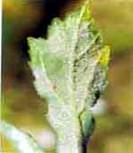  |
| Bacterial diseases : In nature, bacterial canker is found only in tomato. |
|
| Bacterial canker (Clavibacter michiganense) |
|
Symptoms
The bacterium affects the various plant parts that are above the ground. Wilting of leaves and drooping of petioles is observed. Light brown streaks appear on the stem and the petiole later turns black and cankerous. Small, water soaked lesions are seen on the fruits. These turn dark brown, corky and cankerous later.
Causal agent
These are gram positive, non-motile strains of bacteria, which prefer a temperature of 24–27 oC.
Disease cycle
The pathogen is both seed borne and soil borne. Seeds may be the primary source of infection, and soil the secondary source.
Management
- Crop rotation – avoid growing solanaceous crops in sequence.
- Hot water treatment of seeds is desirable.
- Spray cow dung extract
|
| Bacterial leaf spot (Xanthomonas campestris PV. Vesicatoria) |
|
Occurs during the vegetative and fruiting stage.
Symptoms
Leaf spots are small and translucent in the beginning. Later, they enlarge to circular, brown to black greasy spots surrounded with a yellowish halo. Stem lesions are black and canker-like and the fruit lesions are corky. |
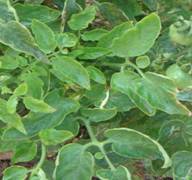 |
| Bacterial wilt (Pseudomonas solanacearum) |
|
This is a deadly disease of tomato. Cultivation of the crop has been abandoned in some parts of the country due to the disease.
Symptoms
Wilting, stunting, yellowing of foliage and a severe case of infection leads to death of the plant. The lower leaves droop before wilting occurs. The vascular system becomes brown. If a segment of a lower stem is cut, it yields bacterial ooze.
Causal agent
The pathogen is soil borne and can persist for long periods.
Management
- Crop rotation with cruciferous vegetables, field bean, maize or soybean
- Seedling root dip in asafoetida solution (@ 10g/litre of water)
|
 |
 |
| Viral diseases |
|
| Tomato mosaic |
|
Tomato mosaic disease is caused by different strains of virus such as tobacco mosaic virus (TMV), cucumber mosaic virus (CMV), potato virus Y and X.
Symptoms
The leaves show light and dark green mosaic symptoms. There is uneven growth of the light and dark green portions. As a result, the normal green patches tend to appear sunken, giving a rough appearance to the leaves. In certain cases, downward curling of the leaves is also seen. In advanced stages, necrosis of the stem, petioles, leaves and fruit is observed.
Management
- Powder neem cake or mustard oil cake, mix it with water and apply near the root region.
- Spray asafoetida solution (@ 10 gm/litre of water). • Spray milk on green house tomatoes to reduce TMV
infection.
|
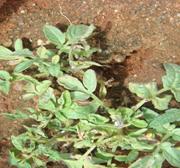 |
| |
| Spotted wilt virus |
|
Vector – Thrips tabaci, Frankliniella insularis, F. occidentalis
Symptoms
Bronzing of the upper surface of young leaves which extends from leaf blade to petiole and stem, causing upward rolling of leaves. Yellow spots are seen on the fruits. |
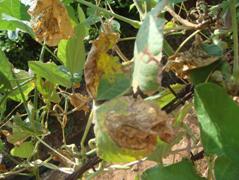 |
| Leaf curl (caused by Gemini virus) |
|
Vector – Bemisia tabaci
Symptoms
The virus causes dwarfing, puckering, severe curling and mottling of the leaves. Downward rolling, crinkling, chlorosis of newly formed leaves and excessive branching are observed and the plants become completely sterile. Association of leaf curl with root knot causes more damage. Occurs during summer (February–June) from seedling to harvest stage.
Economic injury level
Two white flies per leaf or three infected leaves per plant.
Management of viral diseases
- Crop rotation
- Use of virus free seedlings
- Soil sterilisation
- Removal and destruction of diseased plants
- Spraying 5% NSKE or neem leaf extract to control the white
fly vector.
|
 |
| |
| Big bud of tomato |
|
This is on MLO (mycoplasma-like organism) disease transmitted by leafhoppers. The pathogen can survive on alternate hosts like Solanum nigrum.
Management
- Removal and destruction of diseased plants
- Destruction of solanaceous weeds
|
| Root knot nematode (Meloidogyne incognita, M. javanica) |
|
Disease incidence is widespread in the summer and in the spring in north India. Root knot or root galls caused by nematodes are a common disease of many vegetables in tropical and subtropical climates. The infection weakens the plants and pre-disposes them to invasion of many root rot and wilt causing fungi and bacteria, thus compounding the damage.
Symptoms
The plants remain pale and stunted and pod set is extremely low. The leaves are yellowish green or yellow in colour. Drooping and sudden wilting of leaves is observed. So is scorching from the margins inward. Formation of knots or galls in the root system is a characteristic symptom. Maximum number of galls per plant and number of egg masses per gram of root occur when the plants are infected at two-week stage. The main root and the laterals have spherical or elongated galls of various sizes. In advanced stages of infection, these tissues decay and are attacked by other pathogenic and saprophytic organisms. Cultivars like Long Green Smooth, IC- 9273 and IC-18960 are reported to be resistant to root knot nematodes.
Causal agent
Meloidogyne incognita is abundant in cooler and warmer areas whereas M. javanica is common in warmer areas. The nematodes are sedentary endoparasites of roots. The female lays eggs in the host root tissues in masses or egg sacs. The eggs are dormant and do not hatch immediately. An average of about 400–500 eggs are found in a single egg mass. The eggs hatch under suitable environmental conditions. Newly hatched larvae are small, slender and about 0.3–0.5 mm in length. Their movement in the soil is slow and, on contact with host roots, the larvae enter just above the root cap. Upon entering the roots, the larvae move between the undifferentiated cells and reach the endodermis where they become sedentary. They eject secretions while they feed on the cells which cause enlargement of cells or formation of galls.
It is very difficult to control nematodes in an infested field since the eggs survive in the soil protected by host tissues. Nematodes are introduced through infected seedlings and shifting soil from neighbouring infested fields.
Management
- Summer ploughing
- Crop rotation – in the case of cereals, there is a definite
reduction in the population.
- Seed treatment should be carried out with 50 gm
Trichoderma viride/Pseudomonas fluorescens.
- Sow seeds thinly, leaving one inch spacing between the rows.
- Intercrop tomato with marigold.
- Apply neem cake in the main field @ 500 kg/ha or 400
gm/sq. m. in the nursery.
- Attempt soil solarisation before sowing. Cover the nursery
beds with 1 mm thick black polythene sheets for 48 hours to
kill nematodes and weed seeds.
- Fungal species such as Paecilomyces lilacinus, Verticillium
and the bacterium Bacillus penetrans can be used as bio- control agents.
|












